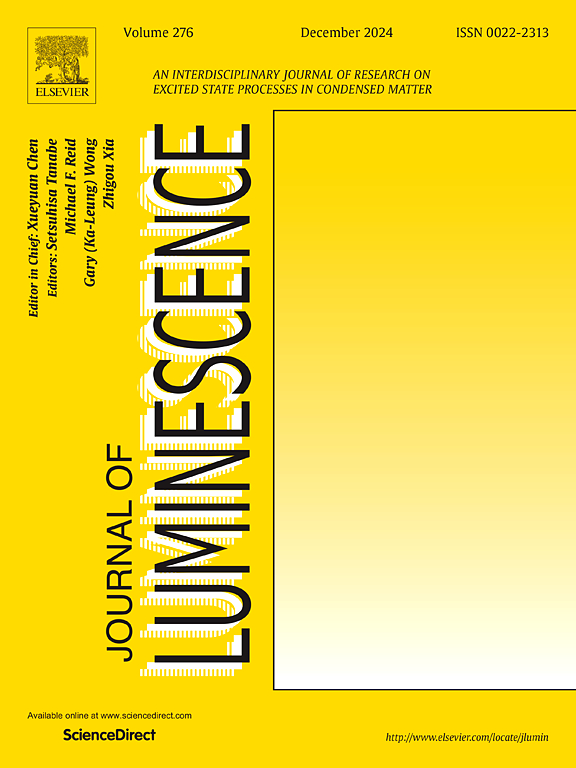Racah参数和Tanabe - Sugano能级图:不同主晶格阳离子种类对晶体场强度参数的影响
IF 3.3
3区 物理与天体物理
Q2 OPTICS
引用次数: 0
摘要
在配位化学中,Racah参数与Tanabe - Sugano (T - S)能级图一起被广泛用于解释金属配合物中电子-电子排斥的影响。为了确定Racah参数(B, C)和晶体场分裂参数(Dq),需要三个激发态零声子线(ZPL)能量,E(2Eg)ZPL, E(4T2g)ZPL和E(4T1g,a)ZPL。然而,从光谱中精确地确定这种激发态ZPL能量是非常困难的。[J]。Lumin. 218(2020) 116,829]通过适当假设r = C/B的Racah参数比来克服这一问题,并证明了其有效性,但未对其验证进行详细讨论。本研究针对这一问题,分析了一些具有代表性的Mn4+和Cr3+活化荧光粉的数据,如K2−IV−F6:Mn4+和Na3−IV−F6:Cr3+, IV = Si, Ge, Sn。详细讨论了不同r值对3d3 -配体特性的影响。引入无量纲Racah参数β1,更详细地检验了修正模型的可接受性和优越性。我们提出的模型揭示了Racah参数和T - S图之间未知的关系,这对于深入理解各种3d离子激活的荧光粉性质及其潜在应用非常重要。本文章由计算机程序翻译,如有差异,请以英文原文为准。
Racah parameters and Tanabe−Sugano energy-level diagram: Effects of the different host-lattice cation species on the crystal-field strength parameters
The Racah parameters in conjunction with the Tanabe−Sugano (T−S) energy-level diagram are widely used as a means of explaining the effects of electron−electron repulsion within the metal complexes in coordination chemistry. For the determination of the Racah parameters (B, C) and crystal-field splitting parameter (Dq), the three excited-state zero-phonon line (ZPL) energies, E(2Eg)ZPL, E(4T2g)ZPL, and E(4T1g,a)ZPL, are required. However, it is very difficult to accurately determine such excited-state ZPL energies from optical spectra. Although a revised model [J. Lumin. 218 (2020) 116,829] was proposed to overcome this by properly assuming the Racah parameter ratio of r = C/B and demonstrated its effectiveness, no detailed discussion has been paid to its validation. The present study focuses on this problem and analyzes some representative data of the Mn4+ and Cr3+-activated phosphors, such as K2−IV−F6:Mn4+ and Na3−IV−F6:Cr3+ with IV = Si, Ge, and Sn. The effects of different r values on the 3d3−ligand characteristics are discussed in detail. The non-dimensional Racah parameter β1 is introduced to examine in more detail the acceptability and superiority of the revised models. Our proposed model reveals the ever-unknown relationships between the Racah parameters and T−S diagram that are important for deeply understanding the various 3d3-ion-activated phosphor properties and their potential applications.
求助全文
通过发布文献求助,成功后即可免费获取论文全文。
去求助
来源期刊

Journal of Luminescence
物理-光学
CiteScore
6.70
自引率
13.90%
发文量
850
审稿时长
3.8 months
期刊介绍:
The purpose of the Journal of Luminescence is to provide a means of communication between scientists in different disciplines who share a common interest in the electronic excited states of molecular, ionic and covalent systems, whether crystalline, amorphous, or liquid.
We invite original papers and reviews on such subjects as: exciton and polariton dynamics, dynamics of localized excited states, energy and charge transport in ordered and disordered systems, radiative and non-radiative recombination, relaxation processes, vibronic interactions in electronic excited states, photochemistry in condensed systems, excited state resonance, double resonance, spin dynamics, selective excitation spectroscopy, hole burning, coherent processes in excited states, (e.g. coherent optical transients, photon echoes, transient gratings), multiphoton processes, optical bistability, photochromism, and new techniques for the study of excited states. This list is not intended to be exhaustive. Papers in the traditional areas of optical spectroscopy (absorption, MCD, luminescence, Raman scattering) are welcome. Papers on applications (phosphors, scintillators, electro- and cathodo-luminescence, radiography, bioimaging, solar energy, energy conversion, etc.) are also welcome if they present results of scientific, rather than only technological interest. However, papers containing purely theoretical results, not related to phenomena in the excited states, as well as papers using luminescence spectroscopy to perform routine analytical chemistry or biochemistry procedures, are outside the scope of the journal. Some exceptions will be possible at the discretion of the editors.
 求助内容:
求助内容: 应助结果提醒方式:
应助结果提醒方式:


